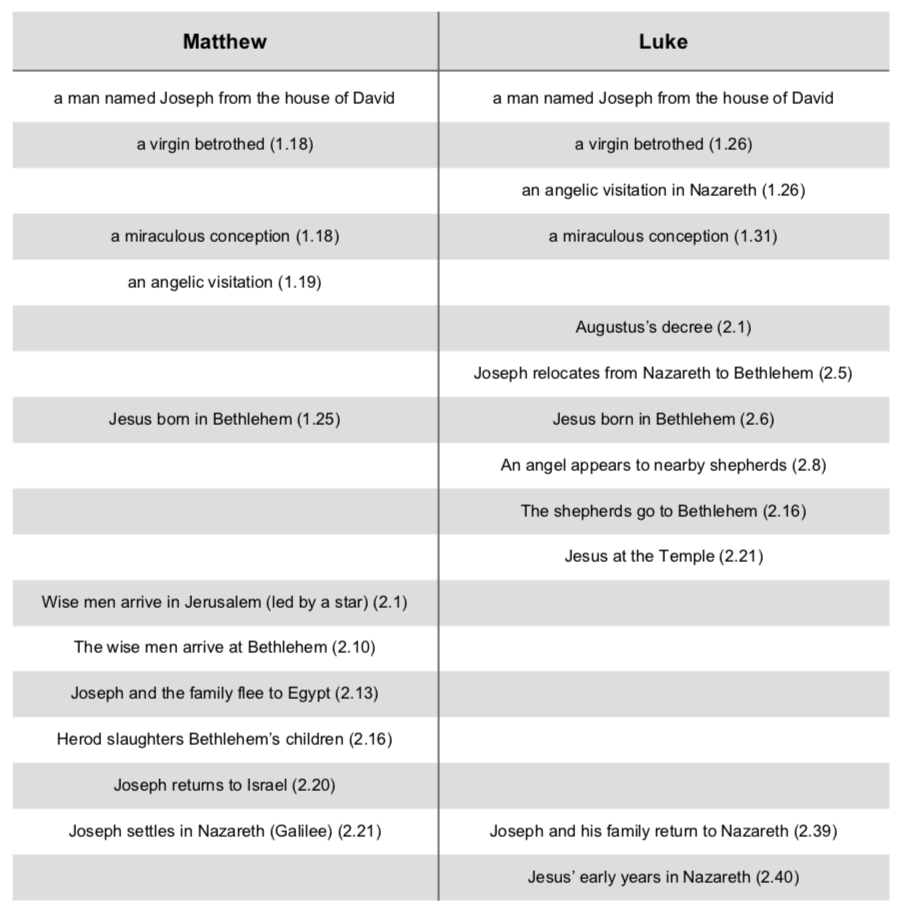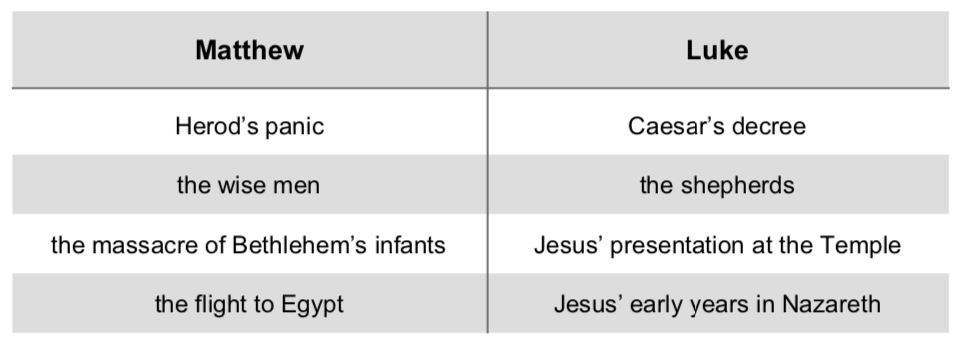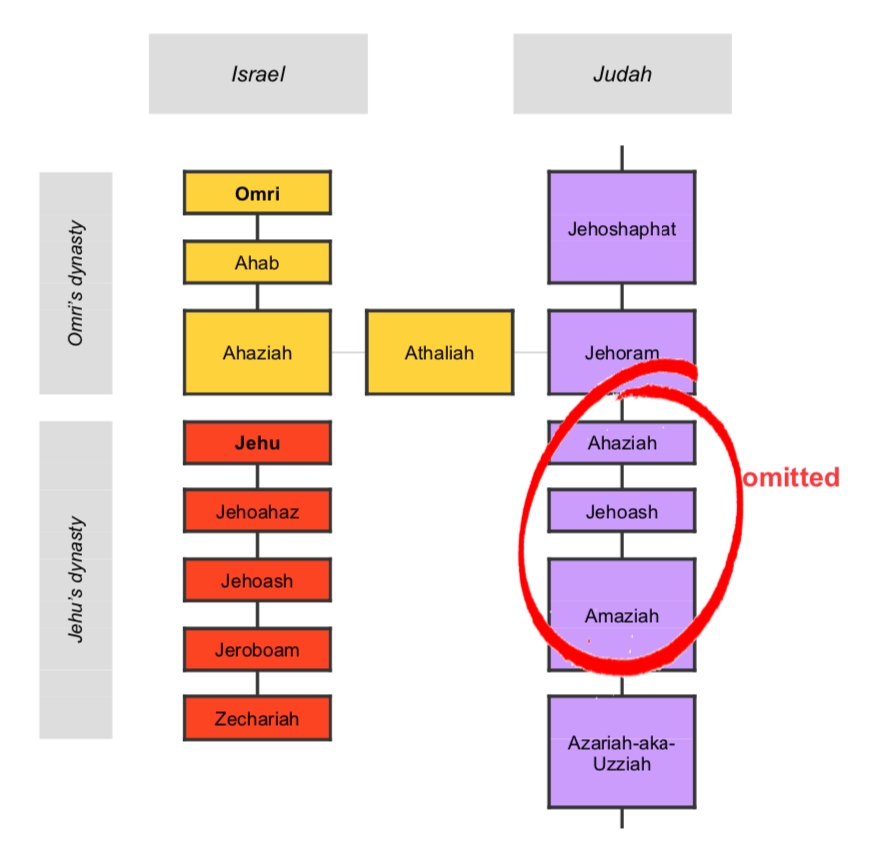James Bejon writes: As Christians, most of us are familiar with harmonised versions of the NT’s birth narratives. We see them acted out each year in Nativity plays (if we subject ourselves to such things). Considered in isolation, however, the birth narratives are less familiar, and even slightly awkward. They gloss over major events. Or, to put the point another way, they don’t mention what we might (reasonably?) expect them to mention. Consequently, most critical commentators dismiss (elements of) them as ahistorical. If Joseph had really fled to Egypt to avoid a massacre, we’re told, Matthew wouldn’t be the only person to mention it. And if Joseph had really ended up in Bethlehem as a result of an empire-wide census, Luke wouldn’t be the only person to mention it. And so it goes on.
But how can such commentators be so sure they know what Matthew and Luke—individuals about whom they can tell us very little—would have wanted to include in their narratives? If their narratives aren’t inherently incompatible (as I’ve sought to show here), and if we can provide plausible reasons why Matthew and Luke might not have wanted to mention the particular incidents they decline to mention, then why should we think their narratives are ahistorical, even in part?
Here, I want to consider whether such reasons can be provided. The hypothesis I’ll advance is as follows. Jesus was born in tumultuous times. The events of his birth included a census, a massacre, a flight to Egypt, and many other things besides, and Matthew and Luke took these events to be significant—i.e., to frame Jesus as the fulfilment of Biblical history—but each writer focused on different aspects of them. For Matthew, Jesus is a Moses-like deliverer, who presents an immediate threat to the world’s Herods. As far as Matthew is concerned, then, Jesus’ presentation at the Temple and childhood in Nazareth are irrelevant, and to include them would be a distraction. Meanwhile, for Luke, Jesus is a more subversive and Samuel-like figure, who grows up and in around the Temple. From Luke’s perspective, then, Jesus’ stay in Bethlehem (after his presentation at the Temple) and flight to Egypt are irrelevant, while his presentation at the Temple and (undramatic) childhood are highly relevant.
That Matthew and Luke don’t write the way we might expect is, therefore, quite true, but it’s evidence not of their ahistoricity, but of the purpose and sophistication of their narratives (not to mention the climactic nature of their Messiah’s entrance into world history). If, by today’s standards, that makes elements of their narratives ahistorical, then it makes elements of their narratives ahistorical. But trustworthiness and conformity to (modern-day) expectations are two different things. Ultimately, if we want to engage with Matthew and Luke in a fruitful way, we need to engage with them on their own terms rather than on the basis of our expectations.
What are the issues?
The best known critical commentary on the NT’s birth narratives is Raymond Brown’s The Birth of the Messiah. It was written over the course of over fifteen years, consists of some 750 pages, and is representative of a much wider body of scholarship. At the conclusion of the book’s introduction, Brown dismisses many elements of the birth narratives as ahistorical. If the census had really taken place, he says, Matthew would have mentioned it as well as Luke. And, if the flight to Egypt had really taken place, Luke would have mentioned it as well as Matthew. And even if the massacre did take place and Luke didn’t mention it, it would be reflected elsewhere in the NT. And so it goes on. Below, we’ll consider the specific details of Matthew and Luke’s narratives and see if we agree with Brown’s assessment of them. (Note: Brown also identifies other issues with the birth narratives, but for now we’ll restrict our discussion to the issue of their internal plausibility.
As I’ve tried to show elsewhere, Matthew and Luke’s narratives are predicated on a common core of events. Both narratives open with a description of a couple who are engaged to be married, namely Mary and Joseph. Both identify Joseph as a man of Davidic descent. Both have Mary conceive by the agency of the Holy Spirit. And both have Jesus born in Bethlehem and subsequently raised in Nazareth.
Nevertheless, Matthew and Luke’s narratives differ in some important respects. Whereas Matthew tells us about Herod, the wise men, the massacre at Bethlehem, and the flight to Egypt, Luke tells us about a different set of events altogether—events which involve Caesar, the shepherds, Jesus’ presentation at the Temple, and Jesus’ childhood in Nazareth. They line up in this way:
Matthew and Luke’s narratives thus frame Jesus’ early years against quite different backdrops, which has led many commentators to question the historicity of Matthew and Luke’s narratives. If Luke was a competent historian, wouldn’t he have been aware of the massacre of Bethlehem’s infants? And, if he was aware of it, why didn’t he mention it? Why does Luke instead have the family head back to Nazareth, with no mention of Joseph’s flight to Egypt? And why, if Luke’s narrative is reliable, doesn’t Matthew mention Caesar’s decree and/or the shepherds? Is it credible to think Matthew was aware of the events recorded in Luke’s narrative and yet declined to mention them (and vice-versa in Luke’s case)?
That all depends on how and why we think the Gospels were composed. If we think Matthew’s aim was to find out as much information as he could about Jesus and then write it all down in a gospel, Matthew’s failure to mention certain events does indeed seem problematic (and likewise in Luke’s case). Very few people, however, think that’s what the gospel-writers did, and for good reason. Consider, for instance, Matthew and Luke’s genealogies. Matthew and Luke were familiar with the OT. Matthew therefore had names available to him which he chose not to include in his genealogy, and Luke had a whole ancestral line (from Shealtiel to David) available to him which he chose not to include in his genealogy (compare 1 Chron 3). More radically, consider the Gospel of John. Do we think John was unaware of the things he didn’t mention in his gospel (e.g., Jesus’ temptations, parables, exorcisms, transfiguration, and institution of the Lord’s supper)?
Like all authors, Matthew and Luke wrote with specific purposes in mind. Each man wanted to tell Jesus’ story in his own way—to highlight particular themes of Jesus’ ministry, to emphasise particular parallels between Jesus’ ministry and OT history, and so on. And if we pay attention to how they did so, it will help us make sense of their selection of material.
Matthew
So, what are the specific purposes of Matthew and Luke’s birth narratives? We’ll start with Matthew’s. Its distinctives can be summarised as follows.
Spelt out more fully: while Luke tells us about Caesar and the census, Matthew tells us about Herod and the massacre of the infants. While Luke tells us about the shepherds, Matthew tells us about the (star-struck) wise men and their gifts. And, while Luke has Jesus at the Temple and/or Nazareth, Matthew has Jesus’ family flee to Egypt.
Now, why has Matthew chosen to tell us about these events in particular (rather than those described by Luke)? What’s their common theme/connection? The answer, I suggest, is that they’re all distinctly exodus-shaped events, which portray Jesus’ birth as a sign of an exodus to come.
Consider some of the relevant parallels. Both stories open with Israel ruled by a foreign overlord (in one case an Egyptian, in the other an Edomite). Both revolve around the birth of a child who’s destined to deliver his people. In both cases, the overlord in question views the child as a threat (cp. Exod. 1.9–10). Both stories have the overlord massacre Israel’s infants in an attempt to secure his position. In both stories, God’s deliverer flees to a foreign land, where he holes out until his enemies have passed away (cp. Matt. 2.20 w. Exod. 4.19). In both stories, God outwits (ἐμπαίζω) his enemies (cp. Matt. 2.16 w. Exod. 10.2). And, in both stories, God’s people are made rich by the Gentiles (cp. Egypt’s wealth w. the wise men’s gifts).
These parallels are no coincidence. Indeed, in Matt. 2.15, Matthew explains the significance of Joseph’s sojourn in Egypt by the citation of Hosea 11.1: ‘Out of Egypt I called my son’. Just as God began a redemptive work in Moses’ day when he called Israel forth from Egypt, so in Joseph’s day God will again call his Son forth from Egypt and begin an even greater redemptive work.
Matthew’s allusions to the exodus, however, aren’t simply a vague anticipation of redemption. They outline a deliberately inverted exodus story. Everything is back to front. The murderous king isn’t an Egyptian Pharaoh, but a ‘king of the Jews’. The land in which God’s son is imperilled isn’t Egypt, but Israel. And the land where the son is accepted isn’t Israel, but Egypt. Why? Because Jesus’ exodus won’t simply be a rerun of the original; it will be a different kind of exodus. The line of division between God’s people and God’s enemies won’t be drawn on the basis of nationality (Israel vs. Egypt: Matt. 8.11–12, 10.34–39), but on the basis of obedience (12.46–50). And, on the night of the Passover to come, God’s firstborn Son won’t escape death.
The relevance of Matthew’s genealogy
That Matthew’s allusions to the exodus are intentional is confirmed by their echoes in Matthew’s genealogy. Consider, for a start, the notion of a foreign ruler who massacres a host of infants in Israel. Matthew’s genealogy also draws our attention to such a ruler, which it does by means of a conspicuous lacuna in its king list.
Suppose I tell you I spent last Christmas with my mum, my brothers, and my sisters. While my statement is ostensibly about my mum, brothers, and sisters, it draws most attention (somewhat paradoxically) to my dad, since it makes you wonder why I haven’t mentioned him.
Matthew’s genealogy works in a similar way. After Jehoram-aka-Joram, the next king mentioned in Matthew’s genealogy is Jehoram’s great-great-grandson (Azariah-aka-Uzziah). Matthew thus fails to mention three Judahite kings: Ahaziah, Joash, and Amaziah.
Why does Matthew omit these three kings? Part of the answer, I suggest, is to draw our attention to a notable sequence of events which transpired in their days. The accession of Ahaziah was a notable event in and of itself, since Ahaziah was the son of Jehoram and Athaliah, and Athaliah was a daughter of the recently-cursed Ahab (2 Kgs. 8.16–18, 25–26). Ahaziah thus represented an unwelcome injection of foreign blood (and behaviour) into David’s line (cp. 2 Chr. 21.13 w. the refs. to Ahab’s influence in 22.1–6). And, a year later, an even more notable event took place: Ahaziah died without any sons old enough to succeed him, at which point Athaliah sought to slay all the potential heirs to the throne and claim it for herself.
Mercifully, however, Ahaziah’s sister managed to spare Ahaziah’s youngest son, Joash, and hide him away (protected by a Gentile guard) until he was old enough to reign (cp. 2 Chr. 22–23).
Consider, then, the situation. We have a foreign ruler in charge of Israel (i.e., an illegitimate ‘king of the Jews’), a newborn child who’s a threat to the ruler’s authority, an attempt to extinguish the ‘line of promise’, and a member of royal family who’s hidden the child away in a foreign environment. Ring any bells? It should do. It’s another exodus event.
Matthew’s king list thus fulfils at least two important functions. First, it underscores the unity of theme of Matthew’s narrative. And, second, it underscores the threat presented by Jesus. Jesus is a legitimate heir to the throne of David, born in the right place at the right time (Matt. 2.3–6), which is why Herod has to eliminate him.
The riches of the Gentiles
A final exodus-like feature of Matthew’s genealogy can be identified in its allusions to the riches of the Gentiles. Its fourteen-fold periodicity highlights four individuals—Abraham, David, Jechoniah, and Jesus—all of whom receive considerable help and riches from Gentile rulers/nations. Abraham emerges from Egypt not only unscathed, but enriched by the land’s silver and gold (Gen. 12.10–13.2). David finds (temporary) refuge among the Philistines and is given silver and gold by Gentile kings (2 Sam. 8.10) (as is his son, Solomon). Jechoniah is shown special favour by the king of Babylon (2 Kgs. 25.27–30), as is his son (Zerubbabel), who emerges from Babylon with silver and gold (Ezra 1–2). And, as we’ve seen, Jesus himself is preserved in a Gentile land and made rich by gifts from foreign lands (compare Exod. 3.22, 11.2, 12.35).
Reflections on Matthew’s narrative
In sum, then, Matthew’s birth narrative is a careful and sophisticated composition, tied together by a clear unity of theme. True, that doesn’t make Matthew’s narrative historical, but it does help to explain Matthew’s selection of material. In the view of many commentators, Matthew and Luke’s birth narratives can’t both be historically accurate because Matthew shows no awareness of Luke’s census or Joseph’s journey to Bethlehem. How, then, do such commentators think Matthew’s narrative should have been written? Well, suppose we rewrite it like this:
And so all the generations from Abraham to David were fourteen generations, and from David to the deportation to Babylon fourteen generations, and from the deportation to Babylon to the Christ fourteen generations.
Now, the birth of Jesus Christ took place in this way: when his mother Mary had been betrothed to Joseph, before they came together she was found to be with child from the Holy Spirit. And, at about that time, a decree went out from Caesar Augustus that all the world should be registered, which was the first registration when Quirinius was governor of Syria. And all went to be registered, each to his own town…
Matthew’s narrative is now more consistent with Luke’s, right? By the same token, however, it’s far less lucid. As we’ve seen, Matthew’s genealogy is crafted in such a way as to anticipate Herod’s hostility, and Matthew’s citation of Hosea explicitly frames Herod and Jesus’ encounter in light of the exodus. Caesar’s involvement in the matter is, therefore, irrelevant to Matthew. Caesar didn’t occupy the throne of David, nor did he see Jesus as a threat, nor did his decree cause Jesus to flee to a foreign land. (Indeed, unlike Herod’s, Caesar’s decree is conducive to the fulfilment of God’s purposes.) Consequently, a description of Caesar’s involvement in Jesus’ birth would only dilute and confuse Matthew’s narrative. And, as we’ll now see, the same is true of Luke’s (mutatis mutandis).
Luke: The Temple rather than the palace
Matthew and Luke’s birth narratives portray Jesus in quite different ways. For Matthew, Jesus is a Davidic king, who presents a threat to Israel’s rulers from the moment of his birth. For Luke, however, Jesus is man of more humble origins. Jesus is no threat to Caesar (as yet) and is more closely associated with the Temple and priesthood than with the throne.
Spelt out more fully:
- Whereas Matthew’s Gospel opens with an announcement of Jesus’ status as the long-awaited son of David (1.1), Luke’s opens with a story about the struggles of a little-known priestly couple and their duties at the Temple.
- Whereas Matthew’s genealogy is headed up by two of the best known figures in Jewish history (Abraham and David) (1.1), Luke’s begins in obscurity and works its way upwards to David and Abraham—a direction of travel elsewhere associated with priestly genealogies (cp. 1 Chr. 6.31–48 w. its context).
- Whereas Matthew’s narrative begins in Bethlehem, Luke’s begins in the Judean hill-country and later relocates to Nazareth—a town of little significance in OT history (John 1.46).
- Whereas Matthew’s Messiah is born king of the Jews (Matt. 2.2), Luke’s begins his ministry at the age of thirty (as all priests do).
- Whereas Matthew’s birth narrative culminates in the declaration ‘The kingdom of heaven is at hand!’ (Matt. 3.1–2), Luke’s culminates in a description of Jesus’ worship at the Temple (and submission to his parents).
- And, whereas Matthew has Jesus offered ‘the kingdoms of the world’ at the conclusion of his temptations, Luke has Jesus brought to the Temple, which is where his Gospel ultimately winds up.
Matthew and Luke thus present Jesus in different ways, though they do so for similar reasons. Just as the distinctives of Matthew’s narrative are intended to frame it against a particular OT backdrop (the exodus), so too are those of Luke’s narrative.
Consider the picture Luke paints for us. We have a priestly couple who are unable to have children, a misunderstood woman whose prayer is finally answered, the birth of a child, a woman who responds in songs of joy, a couple who go up to the house of God each year to worship, and a young boy left at the Temple, where he astounds his seniors with his wisdom, all set against the backdrop of the tenure of two ungodly priests (Annas and Caiaphas) (3.2).
Why has Luke chosen to describe these states of affairs in particular? Are they tied together by a common theme? They are indeed. They’re a recapitulation of a previous birth narrative in the Biblical narrative, namely Samuel’s (1 Sam. 1–2). For Luke, Jesus’ birth doesn’t signal the arrival of a Moses-like leader, but of a Samuel-like servant—a boy who may not be an immediate threat to men like Herod, but who will ultimately turn the world upside down by means of his life and doctrine.
Like Samuel, Jesus will be left at the Temple. From a tender age, his words will astound the wise, and he will grow in favour with God and man. Yet, as time goes on, Jesus’ words will become more contentious (4.22–30). Although they will convert the hearts of some in Israel, they will harden the hearts of others (most notably Jerusalem’s authorities), until, in the end, they spell out the Temple’s judgment. ‘Not one stone will be left on top of another! Jerusalem will fall, the heavens will be shaken, and the Son of Man will come in power and great glory!’ (Luke 21). Like a depth charge, Jesus’ initial arrival in Israel will seem inconsequential, yet it will ultimately bring Jerusalem to its knees.
Luke: Poverty rather than riches
Equally important to note is Luke’s association of Jesus with the poor. While Matthew has Joseph reside in a house, Luke has him lodge in a guestroom. While Matthew has Jesus visited by wise men, Luke has him visited by (mere) shepherds. And, while Matthew has Jesus given gold and precious spices, Luke has him taken to the Temple along with a poor man’s sacrifice (cp. Lev. 12.8).
These details are significant. As far as Luke is concerned, the Gospel is fundamentally for the poor and downtrodden (3.5–6, 4.18, 7.22, 14.11, etc.). Jesus has come to inaugurate a Jubilee—a ‘year of favour’, a time when those who have lost their inheritance are given new hope (4.18–19)—, which is precisely why Luke mentions Caesar’s Jubilee-like decree, with each Israelite returned to his hometown.
Luke’s rationale
As we’ve noted, many commentators are unsatisfied with Luke’s narrative. They expect it to show a greater awareness of the events described in Matthew’s. Suppose, then, we try to include the flight to Egypt in Luke’s narrative (just as we previously tried to include the census in Matthew’s). As it stands, the text of Luke 2.39 reads as follows: ‘When Mary and Joseph had done what was required by the Law of the Lord, they returned to Galilee, to Nazareth’. Suppose we try to incorporate the flight to Egypt in this way:
When Mary and Joseph had done what was required by the Law of the Lord, they went to Egypt for a number of years and later returned to Galilee, to Nazareth…
Luke’s narrative now shows an awareness of its counterpart in Matthew. By the same token, however, it’s a less lucid composition. It also makes us wonder why Mary and Joseph went to Egypt, which (by Brown et al.’s logic) requires Luke to tell us about the massacre in Bethlehem (as well as the wise men’s visit, since the massacre otherwise makes little sense). Yet, as we’ve seen, Luke’s intention isn’t to introduce Jesus as a Moses-like deliverer born into royalty, but as a humble Samuel-like servant, who grows up in obscurity. Consequently, Luke isn’t interested in Herod’s activities. Luke is interested in the lower profile aspects of Jesus’ infancy—in the nearby shepherds rather than the shepherd-king of Micah 5.2, in the Temple rather than the palace, and in Nazareth rather than Bethlehem.
Final reflections
Matthew and Luke’s decisions about what not to include in their birth narratives are often seen as a point against their credibility. (If Matthew knew about Luke’s census, he’d have mentioned it; and if Luke knew about Matthew’s massacre, he’d have mentioned it; and so on.) As we’ve seen, however, Matthew and Luke’s decisions can’t be assessed so simplistically. Matthew and Luke don’t always tell us everything they know, and their omissions serve a purpose.
For Matthew, Jesus is a new Moses, who goes toe to toe with the world’s Pharaoh-like Herods, while, for Luke, Jesus is a more subversive and Samuel-like figure—a man whose ministry lifts up the poor and downtrodden and brings down a corrupt regime. Consequently, Matthew has good reason to mention Herod, the wise men, and the flight to Egypt and not to mention the decree, the shepherds, and Jesus’ visits to the Temple, while Luke has good reason to do the opposite. Contra Brown et al., then, Matthew may have known about Caesar’s decree (etc.) and yet not mentioned it, while Luke may have known about Herod’s massacre (etc.) and yet not mentioned it.
Where, then, do our considerations leave us? If we want to engage with Matthew and Luke in a fruitful way, we need to engage with them on their own terms rather than on the basis of what we think they would (or should) have said (had they known about it). Matthew and Luke describe different aspects of Jesus’ birth since they portray Jesus as the culmination of different strands of biblical history, and a careful consideration of their narratives enables us to appreciate both the sophistication with which they do so as well as the remarkable character of the Saviour they describe.
(Previously posted in April.)
 James Bejon is a junior researcher at Tyndale House—an international evangelical research community based in Cambridge (UK), focused on biblical languages, biblical manuscripts, and the ancient world.
James Bejon is a junior researcher at Tyndale House—an international evangelical research community based in Cambridge (UK), focused on biblical languages, biblical manuscripts, and the ancient world.

































Thank you – this is really interesting. To a certain extent, we have this in the background annually and its really relevant to engaging in honest dialogue with children and adults around the time of the nativity plays etc.. how we explain to children honestly so we are not teaching them to suspend disbelief.. it would be useful to have a harmony of the gospels to be able to acknowledge the events and how they fit together..
This is fascinating and makes so much sense. Thank you!
Would be great to have some new carols (or old ones rewritten) based on one or other theme, that don’t muddy the picture by putting Matthew and Luke in a blender and producing a mish-mash like ‘The First Nowell’.
Agree – this is very useful – it gives a great indication of author intent, why they chose what they did, why the narratives differ.
I remember one lovely lady from Glasgow (now deceased) asking after the carol service `Why are they all singing about being no well? Couldn’t we have something a bit more cheery?’
This article is very enlightening from the standpoint of history. I agree with its insistance we do not meld or conflate the separate birth narratives to our detriment. With that said, the salvific theme running through both does unite them-namely, Israel reduced to one in Christ Jesus. Hence, approaching the birth narrativs with solid grammatical historical hermeneutics, we can and should rejoice at the unity between them. After all, the clearer passages of Holy Scripture illuminate the less clear so that not only the canonical Gospels but the entirety of Holy Scripture remains Christ-centered.
This makes so much sense of the different material in Matthew and in Luke, with their different intentions. Putting the two together, as this article does, then makes it even more incredible that this royal king is also a servant-priest from a poor, humble family.
The perspectives of Matthew’s birth account (mostly Joseph) and Luke’s (mostly Mary) are also quite different and I wonder how significant that might be in the light of the different intentions highlighted here?
Just one small point I would take issue with, which doesn’t affect the key message. I think Stephen Carlson has convincingly argued that Joseph’s home town was actually Bethlehem, so he didn’t ‘re-locate’ to Bethlehem – he took Mary there as his wife, back to his family home (see especially Section 4 of http://www.hypotyposeis.org/papers/Carlson%202010%20NTS.pdf, and previously referenced on Psephizo). Reading Matthew and Luke in that light makes sense of the comments about movements and particularly of Matthew 2.22 where Joseph clearly intended to return to Judea (ie. Bethlehem not Nazareth in Galilee) but moved back to Nazareth because it was outside of the territory of the new ruler Herod Archelaus, who, after repeated complaints, was later deposed and exiled by Rome.
Thank you. Very good analysis indeed. I hadn’t seen it this way before.
For Luke, Jesus is a more subversive and Samuel-like figure.If this is intended to suggest that Samuel is a subversive figure, I have to disagree. And if Jesus is portrayed in Matthew as a threat to the world’s Herods, he is surely a subversive figure in Matthew too. But his kingdom was not by might or power (prior to his coming again), so whether he is thus portrayed in either gospel is questionable. It was only Herod himself who perceived the Messiah as potentially subversive. Jesus was subversive primarily of religious authorities and traditions, in all gospels. While his teaching was – in Nietzsche’s phrase – a revaluation of all values, including the value placed on power, his audience was not the high and mighty.
Both identify Joseph as a man of Davidic descent. This was not necessary to fulfil the prophecy, given that Joseph was not the biological father. A tacit recognition by the Holy Spirit of the legitimacy of being an adoptive father? But note that the NT concept of adoption is different from where a man not legally the father becomes the father. God, when he adopts us, becomes our real father; he truly and actually begets us (e.g. I Pet 1:23).
If Luke was a competent historian… if Luke’s narrative is reliable … I thought this was the point at issue (most critical commentators dismiss elements as ahistorical), in which case it can’t be assumed when countering it.
But in itself, the characterisation of the different perspectives of Matthew and Luke seems true enough, though – and insightful. A historian cannot but select material, and James explains well what guided the selection.
The murderous king isn’t an Egyptian Pharaoh, but a ‘king of the Jews’. The land in which God’s son is imperilled isn’t Egypt, but Israel. And the land where the son is accepted isn’t Israel, but Egypt. Yes, and this also implies that Israel will eventually suffer an Egypt-like catastrophe, judgement for bringing bloodguilt upon the nation (Matt 23:35, 27:25, Acts 2:23, 3:15, 5:28-30). This is the significance of John the Baptist’s warnings (Luke 3:7 et seq). As James goes on to say: Jesus’ words will … convert the hearts of some in Israel, they will harden the hearts of others … until, in the end, they spell out the Temple’s judgment. Actually, more than that. Almost a million Jews lost their lives and nearly all the remainder were deported.
We are facing an even worse fate, as the Gentile world goes through the terminal stages of its own rejection of Christ. Rom 2:9.
Why does Matthew omit these three kings? Part of the answer, I suggest, is to draw our attention to a notable sequence of events which transpired in their days. Not convinced by the idea of drawing attention to something by not mentioning it, least of all by not mentioning it in a genealogy which by its nature gives only names, not events.
Matthew counts 42 generations between the birth of Isaac c. 1850 BC and Christ 1 BC. This is an average of 44 years per generation, which is twice the then average length of a generation from father to son. Thus he omits as many generations as he includes, and there must be a limit to the attempt to come up with theological explanations for the omissions.
That said, the parallelism of a foreign ruler in charge of Israel (i.e., an illegitimate ‘king of the Jews’), a newborn child who’s a threat to the ruler’s authority, an attempt to extinguish the ‘line of promise’, and a member of royal family who’s hidden the child away is undeniably appealing. I would suggest the proper place for remarking on it is II Kings 8-12 rather than Matthew 1. I cannot honestly agree that Matthew’s king list fulfils the two functions suggested.
Does Abraham receive considerable help and riches from Gentile rulers/nations? What about the pointed rejection of such a suggestion (Gen 14:22)? Jechoniah is shown special favour by the king of Babylon. Yes, but he remained a Babylonian captive. One can’t construe this as ‘considerable help and riches’ if this is hendiadys (and if it’s not, finding an instance of one or the other is not difficult). Zerubbabel might fit the bill better, but he is not one of the four highlighted.
Luke’s begins in obscurity and works its way upwards to David and Abraham—a direction of travel elsewhere associated with priestly genealogies. No, it works its way back to Adam, son of God. David and Abraham are just one of many characters along the way, and they are not priests. (Priests belonged to the tribe of Levi, not Judah – the point of Heb 7:11.)
Luke has Jesus brought to the Temple, which is where his Gospel ultimately winds up. Yes, thereby fulfilling the middle part of Mal 3:1.
Did not Abraham set the benchmark for the time between generations? That is 100 years. I think all calculations regarding generations, from the time spent in captivity onwards, should use the century as the marker.
I’m a fan of military history and I have, for example, read several different books on the Battle of Gettysburg. Each author has his own perspective, and each will emphasize certain parts of the battle while omitting other significant events. Yet in the “big picture” they aren’t contradictory by any means. Why should we expect Matthew and Luke to be identical accounts? (BTW- the Holy Spirit inspired these two authors to write exactly what they wrote!) 🙂
That is a really interesting analogy. Thanks.
The main issue for me is the date of the census (6AD?) and the death of Herod (4BC). The rest doesn’t trouble me much.
All that you have expressed here, is understandable. Each gospel writer focused on different aspects of Jesus interaction with the world. Together they paint a full picture. I’ve heard them likened to the four headed beast – Matthew is the lion (Jesus the Lion of Judah), Mark is the ox (Jesus came to serve), Luke is the man (focus on Jesus humanity) and John is the eagle (focus on the spiritual/Godly nature of Jesus ministry on earth). Obviously some overlap exists. However, my question has more to do with the timeliness issue. Matthew clearly presents Jesus as being born before the death of Herod the Great, who died in 4 BC. Whereas Luke states that Jesus birth took place sometime after Quirinius became governor of Syria, which would be after 6 AD. That’s an 11 to 13 year difference if you take into account the visit of the Magi taking place a year or two after Jesus birth, followed by exile to Egypt, massacre of children and subsequent death of Herod. Luke would have Jesus born under the figure head rule of Herod Antipas rather than during the rule of his father Herod the Great. That, to me, appears to be a more significant discrepancy that is difficult to work around and would effect the viability of the census being the reason for Joseph and Mary being in Bethlehem, etc.
Hi! Thanks for the question. I address this in my post on whether Luke got his history wrong. I think your reading of ‘Quirinius’ is not right.
(Also worth noting there is now some debate about the date of Herod’s death…)
Very interesting.
However I’m left with a question regarding how you line up the stories.
Luke 2.21 Jesus at the temple (in Jerusalem according to Luke 2.22)
Matthew 2.1 Magi in Jerusalem
Then the Magi go to Bethlehem, but Jesus is in Jerusalem (No mention of a return to Bethlehem).
Or they stayed in Bethlehem until the Magi visited, took a quick trip to the temple in Jerusalem, had a prophet and prophetess talk about him in Jerusalem, with Herod none the wiser, then they fled to egypt, to avoid Herod.
This matchup doesn’t make much sense.
Case 1, the Magi and Jesus are both in Jerusalem and the Magi can’t find him in Bethlehem, unless Jesus returned to Bethlehem after he was in the temple. Then fled to Egypt. This trip to Jerusalem and back to Bethlehem isn’t mentioned at all.
Case 2, the Magi meet Jesus in Bethlehem, then knowing Herod wants to kill him, they still travel to Jerusalem to present him at the temple. Then flee to Egypt.
Both cases could be possible, but both feel contrived. But he can’t have been in two places at once.
I have a question regarding the timeline as well, but more in how you match them up.
Luke 2:4-6 Move from Nazareth to Bethlehem for census Jesus born in Bethlehem.
Luke 2:21-22 Jesus at the temple, in Jerusalem.
Matthew 2:1-21 Jesus in Bethlehem then in Egypt.
Luke 2:39 Return to Nazareth, because it’s their hometown.
Matthew 2:21-23 Return to Israel, move to Nazareth because fear of Herods son. (Apparently they didn’t live here before, Matthew doesn’t mention where they are untill Jesus is born in Bethlehem).
Another discrepancy for me.
Matthew 2:3 Herod and all of Jerusalem are troubled over news of the Messiah.
Luke 2:22-38 Jesus in Jerusalem with two prophets talking about him to everyone, while Herod is looking for him to kill him.
Herod’s information network in his own city must have been lacking, if the whole city 8s hearing about the messiah through a prophet and prophetess, but Herod is unaware.
So in my mind it’s hard to line these events up.
This post was very helpful. I just listened to a video that discredited the Bible due to the differing birth stories. I believe that your hypothesis is correct. The authors chose to write their stories in such a way to address specific narratives in scripture, both while being able to be simultaneously concurrent, are shown to be seemingly different when seen at surface level. Thank you for your work on this topic.
Indeed. When you read carefully there are no actual discrepancies.